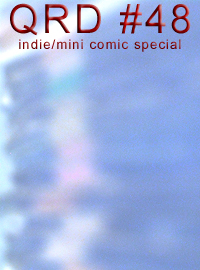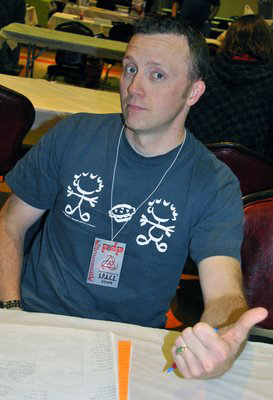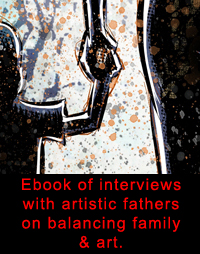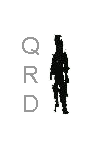








February 2011

City: Nappanee, Indiana
Comics: Rocket Girl, Agent Z, Salem, AZ, Fear of Triangles, Act of Contrition, Sun & Moon, Code Red, Jasmine, Big Breasted Vampire Death, Dare, The Three Keys, Ninja Nympho Roommate, Mysteria’s Mansion, Tentacle Love, Scared Ya!
Websites: www.picklepress.net, pickle-press.livejournal.com
QRD – How old were you when you first got into comics & did you always stick with them or did you come back to them?
Nik – I was probably eight or nine when my Dad started buying me comics. I remember reading them at the barbershop & on the way back from the grocery store while I was still in grade school. I continued reading & collecting them all through high school, college, & even now.
QRD – What was the first comic book you ever bought?
Nik – I’m not sure. It was probably a Spider-Man or Hulk comic.
QRD – How old were you when you put out your first comic?
Nik – 32.
QRD – What decade do you think produced the best comics?
Nik – I’m a sucker for Bronze Age comics because there seemed to be no boundaries. It was also the best time to read horror comics & both DC & Marvel pulled out a bunch of weird characters.
QRD – Why comics instead of just writing or drawing?
Nik – I write all kinds of things. I love comics & got sick of reading junk from Marvel & DC so I decided to make my own. I still write a lot of short erotic fiction, music & film reviews, essays, & screenplays. I also do some editing.
QRD – Do you see mini-comics & indie comics as paths to mainstream comics or as their own unique media?
Nik – Both. Indie comics can be a great way to get yourself noticed, but they are their own animal because they are completely free of other people’s influence. I love indie comics because they are 100% the result of the creative team. No one else has their fingers in the pie.
QRD – How many copies of your comic do you print in your first run?
Nik – 2000. It was far too many.
QRD – How much do you think comics should cost?
Nik – Ideally, no more than three bucks for a 24-pager. I try to keep even my biggest graphic novel at no more than ten dollars per copy.
QRD – How many books do you produce a year & how many would you like to?
Nik – I put out 3 or 4 books a year. If I had limitless time & resources, I’d put out about 15 or so.
QRD – Do you think stories should be serialized or delivered as complete works?
Nik – Both. Some stories work better as cliffhangers & others are better as one long narrative. I write both ways. I will agree with the argument that “the Big Two” are guilty of “writing for the trade” far too often, which leaves new readers lost & helpless to catch up on so much backstory.
QRD – How are comic strips different than comic books & which medium do you prefer?
Nik – Comic strips are great examples of concise writing & three-act structure. Comic books tend to be a little more long-winded just because they have much more space to tell the story. I still prefer comic books, but I appreciate comic strips.
QRD – How long is it from when you start a comic until it’s printed?
Nik – Anywhere from a year to a few months. It depends on the project. Some artists I work with can bang out a 24-pager in less than a month. I can write a rough draft for a 24-pager in less than a day if the idea is flowing well from my brain.
QRD – What do you better with your comics now than when you first started?
Nik – I write better & the whole process from start to finish is more streamlined. I’ve also taught myself to letter comics, which I love doing because it helps me edit my dialogue & it saves me money & time.
QRD – At what point in the artistic process do you work digitally?
Nik – Lettering. I do all my lettering via Adobe Illustrator.
QRD – What do you think of digital comics & webcomics?
Nik – I think they’re fine, but I’m not the type of person to sit down & read an online comic. I’m at a computer enough throughout a day to want to sit down & read a 24-pager online. I also like the physical feel of a comic book in my hands.
QRD – Do you prefer working in color or black & white?
Nik – Black & white, mainly because it’s cheaper & I can get the books out faster. Some books also just look better in black & white.
QRD – How many different people should work on a comic & what should their jobs be?
Nik – I work well with no more than four people. It’s usually me, a penciler, an inker, & a colorist. Sometimes the “art team” is all one person, which saves me a lot of time.
QRD – How do you find collaborators?
Nik – Online & at comic book shows. I’ve worked with artists all the way in Indonesia thanks to the Internet.
QRD – How tight do you think a script should be as far as telling the artist what to draw?
Nik – I’m very much a “bare bones” scripter. I’ll give the essentials of what needs to be in the panel & where the characters should be in each panel (which makes lettering easier later), but that’s it. I don’t care what the backgrounds look like unless it’s crucial to the story. I am, however, detailed with my fight scenes. That’s due to me being a martial arts instructor & envisioning the fights almost as movie scenes.
QRD – What comic book person would you be most flattered to be compared to?
Nik – Some of my friends have compared me to the old pulp fiction writers who could & would bang out a dozen books a year. If I had to pick one comic book pro, it would probably be Keith Giffen. He’s a major influence on my writing style & I like how he’ll write everything from all-ages to XXX material.
QRD – What do your friends & family think of your comics?
Nik – They love them. I was a bit surprised at how I’ve received no flak from any of my family or friends about my adults-only work.
QRD – What do you think of superheroes?
Nik – I have no problem with them. A lot of people are coming down on them as of late, but superheroes are just another tool to tell a story. They’re fun to write. Anyone who says otherwise is lying.
QRD – Marvel or DC?
Nik – I lean toward DC because they tend to focus more on the story than the art, but I’m out of the loop on mainstream comics. I don’t get to the comic book shop as much as I’d like. When I do get there, I’m hopelessly lost. There were so many “Blackest Night” crossovers that I didn’t know where to begin.
QRD – What comic characters other than your own would you like to work with?
Nik – I’d love to write Vampirella, The Flash, Shang-Chi, Lady Shiva, Batman, & Thor comics.
QRD – Ideally would you self-publish?
Nik – I already do. If you’re wondering if I’d self-publish even if I worked for Marvel or DC, the answer is yes. I have too many ideas to contain them.
QRD – What conventions do you try to attend & why?
Nik – I always try to make it to SPACE, GlamourCon, & Flashback Weekend. SPACE is a fantastic all-indie show & one of the best shows in the Midwest. GlamourCon is all exotic models & pin-up artists, so who wouldn’t want to attend that? Flashback Weekend is a great horror show in Chicagoland that is well-organized & a fun time.
QRD – What do you do to promote your books?
Nik – I keep my website & blog updated & attend a lot of different shows. I don’t limit myself to comic book shows. I work a lot of horror shows, glamour shows, adult industry shows, & I’m starting to hit anime shows.
QRD – Do you think your comics are well suited to comic shops or would sell better elsewhere?
Nik – They are, yes. I publish a wide variety of genres so my stuff definitely falls into the “Do you have anything other than superhero books?” category.
QRD – What other medium would you like to see some of your comics made into (television, film, games, action figures, etc.)?
Nik – Some of my comics would make interesting films, & I’d love to see some of my adult material turned into an adult film. I’d be laughing the whole time.
QRD – Do you consider yourself a comic collector or a comic reader or both?
Nik – Both. I have a large collection. I used to be a completist, but I’ve evolved into a person who buys something just because it looks interesting or weird.
QRD – What do you see as the most viable mediums for comics distribution 10 years from now?
Nik – By that time, comic books will probably be even more of a niche market, so smaller distributors will be the way to go for creators like me. I think a lot of comics will go all-digital, but there will always be a large group that want the physical copies.
QRD – What would you like to see more people doing with comics?
Nik – Reading them. I’m amazed at how many people don’t realize that comics are a vast medium with many different stories to tell.
QRD – Anything else?
Nik – I just encourage everyone to check
out all sorts of comics & to always work your way to the back of any
comic book convention you attend. Look for the “artists alley” section
of your local comic book show. The best stuff is always back there.







